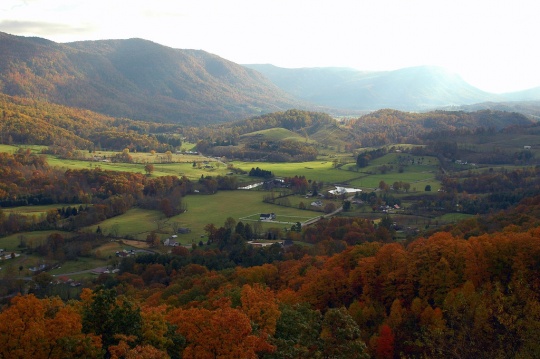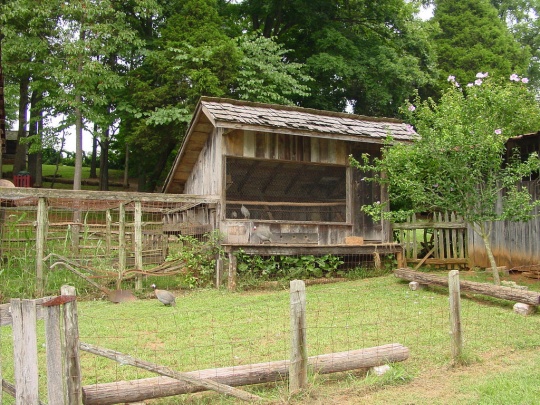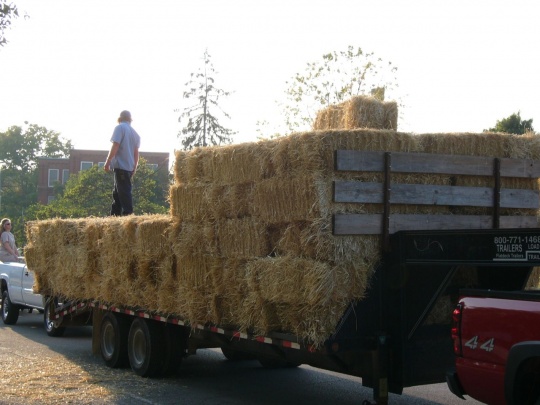Eating Appalachia: In Search of Real American Cuisine in Hidden Hollers

Photo by Radio Rover
What qualifies as truly American cuisine? In this first installment of a four-part series, Eat Me Daily’s Kathleen Willcox explores the question through the prism of Appalachia and its intrinsically delightful, regional cooking style. With recipes!
From the American Revolution onward, food wonks have been doing battle over the definition (and very existence) of authentically American cookery. James Beard himself wasn’t even positive if there was such a thing as American cuisine, saying that “I think we have good food and we don’t need to label it. We have one important thing that grew up in this country and that is the definition of regional cooking … we have a breadth of view and understanding.”
Beard was onto something. Among other things, the sheer size, immigration and settling patterns of the United States has snookered any attempt to document, define and dispatch, a la Careme and Escoffier in France, a systematic distillation of our sprawling, disparate nation’s various food traditions into one neat package. Instead, we’re left with a wealth of delightful regional cuisines to celebrate and fight over, all of which are developed and perpetuated by the tried-and-true methods of word of mouth and recipe swaps. The food of Appalachia is perhaps the truest example of this hyperlocal, community-driven cuisine.

Photo by cw
The origins of the original
"Regional cuisines develop in unpredictable ways and spread like wildfire,” Mark Sohn told me. Sohn, a writer and expert on mountain food, has lived in Appalachia for three decades and the scribe of the soon-to-be released Bourbon: A Kentucky Tradition (American Foodways Press, March 2009) “It’s very possible for one dish to develop in a tiny geographical area and just fan out into the region at large; or just remain unique to the tiny town it was developed in. Take France: each tiny region has a cheese or a wine, often created by one family of cheese or winemakers that’s particular to that area.”
Despite its unique position as one of the oldest, most constant forms of American cookery, classic Appalachian cuisine is the red-headed stepchild of regional cuisines. Sohn enumerated Appalachia’s culinary idiosyncracies: “It has ingredients like ramp and sassafras; recipes like dried apple stack-cakes, cream-pull candy and sweet potato biscuits, and unique pairings like potatoes and gravy and all kinds of things with bologna, from gravy to a salad we have called funeral home salad.” And the roots run deep — “it really goes back as far as 15,000 or so years ago when you had Cherokee people settle in the region. Then of course, Italians, Germans, English, Scots, Irish, Spanish and even more recently, Hispanic immigrants came and they all influenced the food traditions, initially incorporating their European roots with foods that the native populations ate. White settlers were helped immeasurably by the native population and their mark remains on the food today.”
The holy trinity of Appalachian ingredients is corn, beans and squash – something that has remained unchanged for hundreds, if not thousands of years — when white settlers arrived, they found those crops and others already being grown by Native Americans. Because the region is geographically isolated, settlers and successive generations ate what they could grow. As a result, traditional Appalachian food is flavored with locally grown ramps, hot chilies, ginger, honey, sweet sorghum syrup. It's all brought home with a generous dose of lard and meat drippings — meat, primarily roasted or smoked pork and chicken, was generally used as a flavoring ingredient, not the main attraction.

Photo by jon1204pdt
The accidentally hip cuisine
Often, Appalachia’s trademark dishes look like they belong on chicly worn New Brooklyn Cuisine restaurant menus. It wouldn't be out of place to see ironically mulleted hipsters ordering preparations like like chow chow, a pickled vegetable relish comprised of local vegetables including cabbage, lima beans, apples, green tomatoes, green beans, onions, corn and cucumbers; or dishing up ten bucks for a serving of soup beans, a pinto bean dish flavored with pork, lard and salt.
Contemporary food hipsterdom seems to have intersected almost uncannily with the foundations of Appalachian cuisine. A natural adoption of local, sustainable, and organic principles means that Appalachia really should be ground zero for city-slickers planning their next culinary odyssey.
But interestingly, the region and its entire glorious repertoire of (unintentionally virtuous) delights is generally overlooked and ignored. And it’s not just food-trend obsessed blowhards who fail to recognize the potential of Appalachian cooking; the region and its cuisine are dismissed offhand by vitually everyone who isn’t from the region. It’s hard not to think that this neglect comes from a place ofsnobbery, ignorance and an irrational fear of hillbillies — a group Sohn calls “the last acceptable stereotype.”

Photo by cw
Who's afraid of hillbillies?
The thing is, Appalachia isn’t all hillbillies. “What people have to understand is that most of the people out here are just regular middle-class folks,” Sohn said. “Sure there are problems, but problems exist everywhere. Very few people have gardens these days, never mind farms with pigs and chickens running around. Maybe 1 in 10,000 people out here has a pig it’s raising as a hobby – but most people just don’t want to see that.” Sohn mentions a recent episode of the show 20/20 that purported to show the “real” Appalachia. “A lot of people I’ve talked to out here think the region was not represented accurately at all.”
Though some residents in the area believed the show (featuring families marked by incest, drug addiction, alcoholism, ne’er do wells and, yes, Mountain Dew-induced tooth decay) was not entirely without journalistic merit, its oversimplification of Appalachian culture left most residents of the region appalled. The mayor of Hazard, Kentucky, rather succinctly referred to it as a “load of crap.”
Too late for the real thing?
Many in-the-know food hounds may have been discouraged from sniffing around the fragrant hills and valleys of Georgia, Kentucky and Tennessee by a fear of a Deliverance-style ass-whooping, but those who aren’t may be too late. The purity of the region’s agriculture and cuisine has been slowly fading as the coal mine industry, McDonald’s, and microwave meals moved in and replaced independent farms, homemade chicken and dumplings, and front-yard gardens. Like the rest of the country, most Appalachians opt to pick up a Quarter Pounder with cheese or a box of Bisquick instead of going to all that trouble to whip up a pork salad or new potatoes and gravy.
There is hope though – as Appalachia finally starts to move onto the national culinary stage, an unofficial movement is afoot among local restaurateurs, cultural talking heads, and general fans. They're starting to preserve the recipes, cooking style, and commitment to traditional, locally grown food, working to keep Appalachia's culinary bounty from disappearing along with the region’s ad-hoc gardens and hand-raised chickens and pigs.
In spite of the region's slow decline (and due in some part to the folks committed to its preservation), there are still enclaves of authentic Appalachia that flourish. In future installments on Appalachian grub, we’re going to explore the best places to (still!) find authentic chow chow and soup beans, the best under-the-radar mountain food fests, and the current — and future — state of Appalachian cuisine. To tide you over, here’s a tried-and-true mountain recipe, courtesy of Sohn, that’s sure to make you want to holler for the hollers.
–Kathleen Willcox
Recipe: Dried Apple Stack Cakes
This authentic Appalachian recipe is courtesy of Mark Sohn
Note: The apple filling should be prepared ahead of time and allowed to cool.
For dried apple filling:
18oz soft-dried apples
4 3/4 cups water or apple cider
1 cup sugar
1 tsp. ginger
1 tsp. ground nutmeg
For stack cake:
5 cups plus 1/4 cup flour, divided
1/2 cup sugar
2 tsp. baking powder
2 tsp. ground ginger
1 tsp. cinnamon
1 tsp. salt
1 cup melted shortening
1 cup pure sweet sorghum (you can substitute molasses or dark corn syrup)
2 eggs
2 tsp. vanilla
For the glaze:
1 1/4 cups sugar
1/3 cup water
1/4 cup shortening or butter
1 tsp. ginger
1 tsp. vanilla
For the filling:
1. Bring apples, water and sugar to a boil and let simmer for 30 minutes, stirring to combine.
2. Stir in ginger and nutmeg. Using a mixer, food processor or potato masher, break up apples and blend until they have an applesauce-like consistency. Let cool before proceeding with the cake and glaze.
For the cake:
1. Heat oven to 350 degrees and grease several 9-inch non-stick cake pans. (You can reuse pans if necessary).
2. Mix the 5 cups flour and other dry ingredients in large bowl, reserving the 1/4 cup flour.
3. Make a well in center of flour mixture and pour in shortening, sorghum and vanilla. Crack the eggs, and drop them in. Whisk until well-mixed. Using your hands, slowly incorporate flour as you would with bread. When the dough is dry enough to handle easily, stop adding flour. (If the dough is too dry, moisten it with a little water).
4. Roll the dough into a log and cut into 6 equal-sized pieces . Form the pieces into balls and evenly roll in the extra 1/4 cup flour.
5. Roll out each ball, making rounds that are 8-9 inches in diameter. Place each layer (by rolling or folding) in a greased 9-inch pan. Unroll dough and pat evenly across bottom. Bake 12 minutes or until brown on edges and light brown across the top. Repeat for each layer.
6. Remove layers from oven and cool on racks. When all layers are cool, spread filling and stack layers.
To assemble:
1. Place first layer on cake plate and spread 3/4 cup filling over each layer. Repeat with each layer, leaving the top layer uncovered.
2. Let the cake stand six to 12 hours at room temperature (this allows moisture from the filling to seep into the layers). Refrigerate 12-36 hours before serving.
3. Brush the top of the cake with egg white before it’s refrigerated or just prior to serving. Dust with powdered sugar. Serve as is, or with glaze.
For the glaze:
1. Combine sugar and water in small saucepan over high heat. Bring to boil, simmer for eight minutes or until it reaches the soft ball stage (around 234 to 236 degrees).
2. Remove from heat, slice and stir in butter or shortening, then ginger and vanilla. Pour glaze over cake, starting at the edges, dripping it down the sides. Spread remainder on top of cake with a knife.

No comments:
Post a Comment